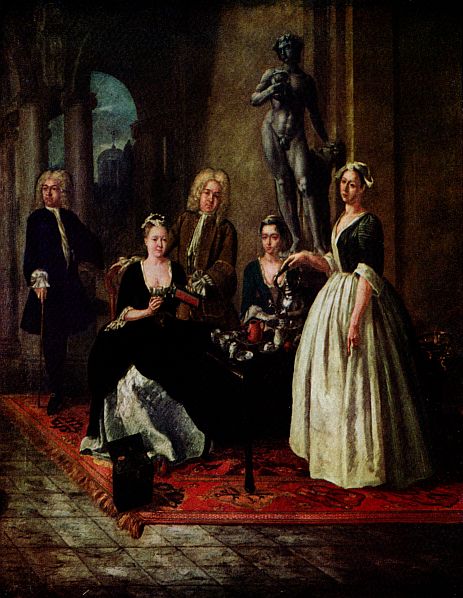E-text prepared by
Chris Curnow, Walt Farrell, Joseph Cooper,
and the Online Distributed Proofreading Team
()
TRANSCRIBER’S NOTE
The text contains many references to the figures.If you follow one of the links from the text to afigure you will need to use your browser’s or your ereader device’s“Back” button to return to your original place in the text.
An additional transcriber’s note is at the end of the book.

Tea Drinking in 18th-Century America:
Its Etiquette and Equipage
Rodris Roth

An English Family at Tea. Detail from an oil painting attributed to Joseph Van Aken, about 1720. In collection of Victoria and Albert Museum. Crown Copyright. (Color plate courtesy of the Saturday Book.)
In 18th-century America, the pleasant practice of taking tea athome was an established social custom with a recognized code of mannersand distinctive furnishings. Pride was taken in a correct andfashionable tea table whose equipage included much more than teapot,cups, and saucers.
It was usually the duty of the mistress to make and pour the tea;and it was the duty of the guests to be adept at handling a teacup andsaucer and to provide social “chitchat.” Because of the expense andtime involved, the tea party was limited to the upper classes;consequently, such an affair was a status symbol. The cocktailparty of the 20th century has, perhaps, replaced the tea party of the18th century as a social custom, reflecting the contrast between therelaxed atmosphere of yesterday with the hurried pace of today.
The Author: Miss Roth is assistant curator of culturalhistory in the United States National Museum, SmithsonianInstitution.
The Americans “use much tea,” noted the AbbéRobin during his visit to this country in 1781.“The greatest mark of civility and welcomethey can show you, is to invite you to drink it withthem.”[1]
Tea was the social beverage of the 18th century;serving it was a sign of politeness and hospitality, anddrinking it was a custom with distinctive manners andspecific equipment. Most discussions of the commodityhave dealt only with its political, historical,or economic importance; however, in order to understandthe place tea holds in this country’s past, italso is important to consider the beverage in term